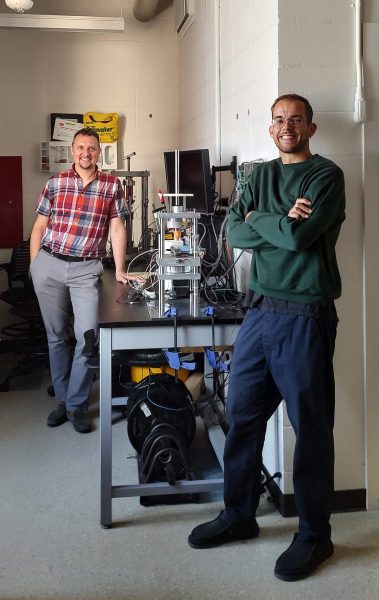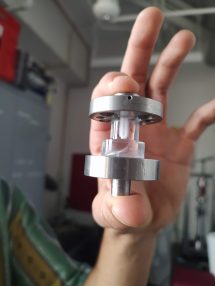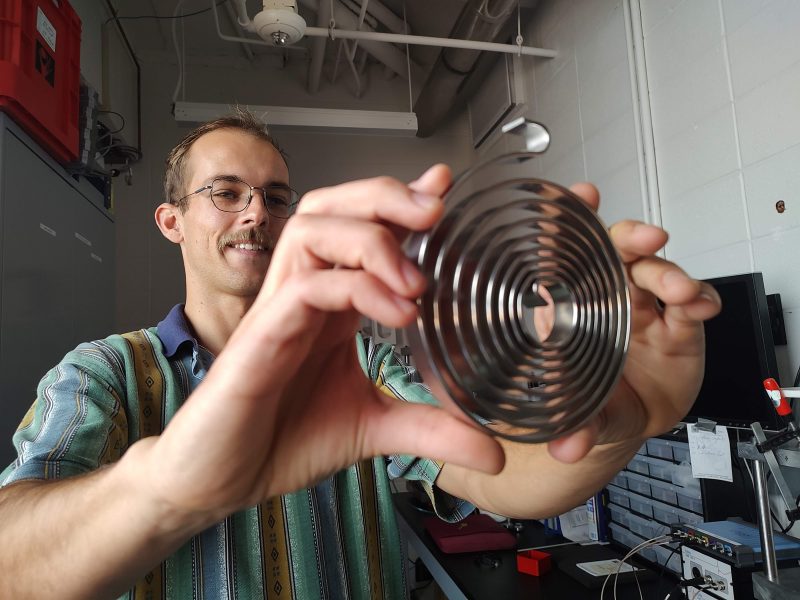Making Quakes on Campus
April 12, 2023

Researchers at the Jackson School of Geosciences sometimes investigate earthquakes by going right to the source, such as subduction zones along the coasts of Japan or New Zealand or seismic hotspots in West Texas.
But sometimes, they study them by making them in house.
An earthquake machine in the lab of Professor Nicola Tisato, who is part of the Jackson School’s Department of Geological Sciences, is helping researchers learn more about earthquakes and what triggers them by recreating the entire earthquake cycle in miniature.
The earthquakes are miniscule. A “big one” releases about as much energy as a bag of flour hitting the ground. But according to Tisato, collecting data on these lab-generated quakes could help with predicting when and where the real things might occur.
“This machine could become very important for the forecasting of earthquakes because we have signals coming from several sensors that we’re using to monitor the fault,” Tisato said. “We can see the signals that are produced right before big events.”
Working with collaborators, Tisato built the machine about 10 years ago when he was a postdoctoral researcher at ETH Zurich but left it behind as he continued on in his career. Now with an established lab space in the Jackson School, he brought the machine from Switzerland to Texas to restart earthquake experiments on it.
Tisato recently received a grant from the National Science Foundation to carry out these experiments. And there are already promising early results, such as those in a recent study in the Journal of Geophysical Research Solid Earth. Led by Jackson School Ph.D. candidate Ethan Conrad, the study revealed that the motion of faults and the sound waves emitted creates a soundtrack linked to the physical mechanisms that control earthquake behavior.
The sounds they produce range from crackling microfractures to booming ruptures.
“We can hear the sound of the strengthening and weakening mechanisms, and when we look at the frequency spectrum, we can start to piece together different frequency bands that are associated with those mechanisms,” said Conrad.
That means that buried in these sounds are frequency-specific signals that provide a play-by-play of what’s physically happening along the fault.

There are many ways to recreate earthquakes in the lab, with researchers at the Jackson School using different machines to study different aspects of fault behavior. Tisato’s machine is a type of rotary shear apparatus. Called an ECoR, for “energy controlled rotary apparatus,” the machine gradually applies stress to a fault until it slips, creating an earthquake. The fault is represented by the meeting point of two stacked pucks of plexiglass, each just a couple inches in circumference. At room temperature, the plexiglass has similar properties as granite hundreds of meters below the Earth’s surface, where many large earthquakes start.
Like other rotary shear devices used to study earthquake behavior, the ECoR can continually create the cycle of stress buildup and release that powers earthquakes. The plexiglass pucks spin in place, sticking and slipping, as they rotate. This allows researchers to watch how the fault changes as it is subjected to stress over time – and how this changes the strength and character of the quakes.
But what sets apart Tisato’s machine is how that stress is applied. Other rotary shear machines apply horizontal force directly to the fault, imposing a quake on demand. Tisato’s machine uses a large circular spring – similar to the springs that power wind-up pocket watches – as a mediator, allowing the stress to gradually build on the fault until a quake spontaneously happens. Tisato thinks that makes for a more realistic representation of the constant tectonic forces pushing on real world faults.

“A benefit of our machine is it lets the earthquakes occur spontaneously,” Conrad said. “For the rotary case, this is the first sort of machine that can really do that.”
Right now, Tisato and Conrad are continuing to generate and monitor earthquakes on the machine with plexiglass pucks and other geological stand-ins. Recently they have been using the machine to study different granular materials that can be used to create physical models of mountain building. As part of the NSF-funded project, Tisato has plans to run the experiments on a larger version of his earthquake machine at the University of Oklahoma to see if scaling up the faults and forces leads to any changes.
Once enough data is collected, the next step is to apply machine learning to the data and see if the machine’s spontaneous earthquakes can actually be forecast in advance. If that can happen in the lab, it’s possible that the same thing could be done for actual earthquakes, given detailed enough seismic data, said Tisato.
Chris Marone, an earthquake scientist and professor at Penn State who was not involved with the research, said that although seismologists have been listening to earthquakes crack and squeak in nature and in the lab for the past 50 years, Tisato’s machine represents an exciting development because of its realistic manner of applying stress, and the potential for machine learning to reveal new insights in the data it produces.
“I think people will be very excited about these capabilities,” Marone said.
